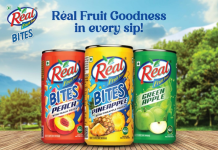In the beginning was Ayurveda. Then came Baba Ramdev, and all Things were made by him. And begat he a shampoo-to-noodles empire, and all around him were vanquished.
Patanjali Ayurveda (Rs. 4000+ crore) is FMCG’s most salient brand, and the most analyzed. A spectrum of theories tracks its rocket-like rise — a branded-house architecture, its distribution model, low cost structure, its promoter’s charisma. But most intriguing is the explanation that one of the boosters of the Patanjali rocket is: bad design.
Patanjali’s packaging, advertising imagery and point-of-sale presence could be called dismal. One of packaging’s key jobs is to signal quality. But Patanjali’s sloppy, nondescript typography, garish color palettes and crude Illustrations bring to mind ‘cheap’ rather than inexpensive.
No Unilever manager would pass this packaging; but Patanjali grew 100% last year, Unilever at 4%. What’s going on?
I talked to a range of consumers and non-consumers, from those who read the Business Standard (or ought to!) to citizens of Delhi’s lower middle class. No fans of Mr Ramdev; mainly agnostics, un-believers and a couple unaware (yes!) of his connection with Patanjali.
Most see this crudity as a marker of genuineness and quality, (some said they wouldn’t buy it, but could see why others would). It casts Patanjali in a ‘rural’ persona, too artless to access design. This chain of meanings links to purity and an untouched-by-progress quality that account for the ‘true’ flavour of its ghee and the efficacy of its toothpaste. Just ask around.
 Indeed this yearning for the ‘remembered village’ lies at the root of all ‘goodness’ products. It can also be seen as part of a worldwide, visceral distrust of the modern corporation and the city. The late Wally Olins, the influential British observer and practitioner of branding called it the ‘new authenticity.’ It drives people to organic and ethical brands, no-label labels, rooted in place and made by people. At a higher level, it fuels Occupy Wall Street on the left, and on the right, a demand for a plain speaking ‘authentic’ Erdogan or Trump.
Indeed this yearning for the ‘remembered village’ lies at the root of all ‘goodness’ products. It can also be seen as part of a worldwide, visceral distrust of the modern corporation and the city. The late Wally Olins, the influential British observer and practitioner of branding called it the ‘new authenticity.’ It drives people to organic and ethical brands, no-label labels, rooted in place and made by people. At a higher level, it fuels Occupy Wall Street on the left, and on the right, a demand for a plain speaking ‘authentic’ Erdogan or Trump.
Is this ‘bad’ design deliberate? Sumit Roy, a well-known brand coach told me it was “actually very good design with an Ayurvedic feel, as deliberate as Baba Ramdev’s clothes and hair.”
But deliberate? Not unless you see Mr. Ramdev’s kesh and vesh as pure brand projection rather than lifestyle choice. And not unless Patanjali actually instructs its designers to stumble, like the circus joker adept at circus arts who clumsily ‘falls’ from the trapeze, losing his pyjamas on the way.
(An interesting side question: is deliberate still authentic? Dabur, a leading Ayurveda brand that must be feeling the heat, proposes a science-based Ayurveda, and cultivates an Ayurvedic feel, designed with the acumen expected of a modern marketer. Home assignment: compare Dabur with Patanjali on the dimension of authenticity. Who wins?)
Notice that Patanjali’s designs are not simply earthy, or with a culturally specific or kitschy charm, like Rooh Afza is. Nor do they project a lack of means: their packs are well made, of expensive material. Patanjali’s design intent appears to be to emulate the ‘enemy’s’ visual style, in much the same way that urban ugliness is often an awful homage to international architecture. So bad, that they’re good?
To say that specifically low-quality cues signal authenticity flies in face of evidence. Or is it that packaging doesn’t count for Patanjali? The mechanism at work is ‘judgement by priors’ or a form of confirmation bias. Since Mr Ramdev guarantees authenticity (prior fact), all later stimuli are seen as evidence of it; this is intelligence in its role as a rationalizing machine.
The lessons for, and from, design are several
One, personality matters in packaging, beyond personalities. Even Patanjali buyers who didn’t know Mr Ramdev was behind Patanjali, couldn’t help forming these impressions from the packaging: ‘economical,’ ‘genuine’ ‘closest to fresh.’ Clearly, these packs seem to tellingly convey Patanjali’s personality traits. Revealing Mr Ramdev’s role did not reverse their impressions of Patanjali, even when they were not approving of Mr Ramdev’s public persona. Clearly, some ethical perceptions trump others.
But would Patanjali fly higher with well-designed packaging that cues quality, reliability and trust? Anant Rangaswami, editor of the TV program Storyboard, says that Patanjali’s noodles would give Nestle a bigger fright if they were better designed.
Yes, with a caveat. Taste is a slippery guide to good design — it is a cultural phenomenon, dependant on class. There are no universals. Audience specific cues need to be understood and engineered.
 Even Patanjali’s packaging holds some valuable clues, available to the interpreter. If it can extract its particular brand of ayurvedic appeal, and apply it to packaging and beyond, Patanjali can enlarge its audience to take in affluent doubters and earn a better price. It can do this without losing its grip on the imagination of the millions who are driving its rise. Earthy, rural or authentic don’t need ‘bad’ design. A good story like Mr Ramdev may survive bad design, but good design, correctly defined, can further it.
Even Patanjali’s packaging holds some valuable clues, available to the interpreter. If it can extract its particular brand of ayurvedic appeal, and apply it to packaging and beyond, Patanjali can enlarge its audience to take in affluent doubters and earn a better price. It can do this without losing its grip on the imagination of the millions who are driving its rise. Earthy, rural or authentic don’t need ‘bad’ design. A good story like Mr Ramdev may survive bad design, but good design, correctly defined, can further it.
Itu Chaudhuri is a principal at ICD. He writes broadly on design, taking in connected subjects. He says, “Sometimes I will offer a way of thinking about problems clients may be facing, and sometimes I will propose new problems. I promise not to say ‘design thinking’ unless it’s in a takedown.”
http://icdindia.com/blog/bad-design-my-goodness/ This article first appeared in the 18th June 2016 issue of Business Standard under the column ‘Deep Design’ by Itu Chaudhuri. Reprinted by permission of the author.
Packaging Soth Asia is a cooperating media partner for drupa 2016 which was held from 31 May to 10 June at Dusseldorf, Germany











